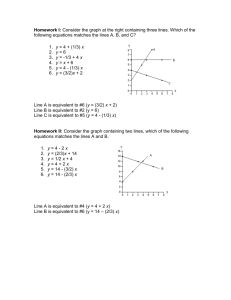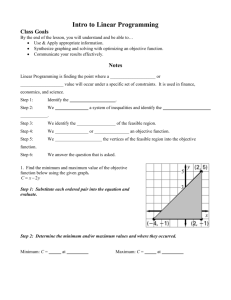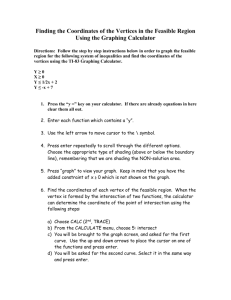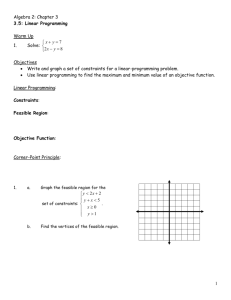2.1
advertisement
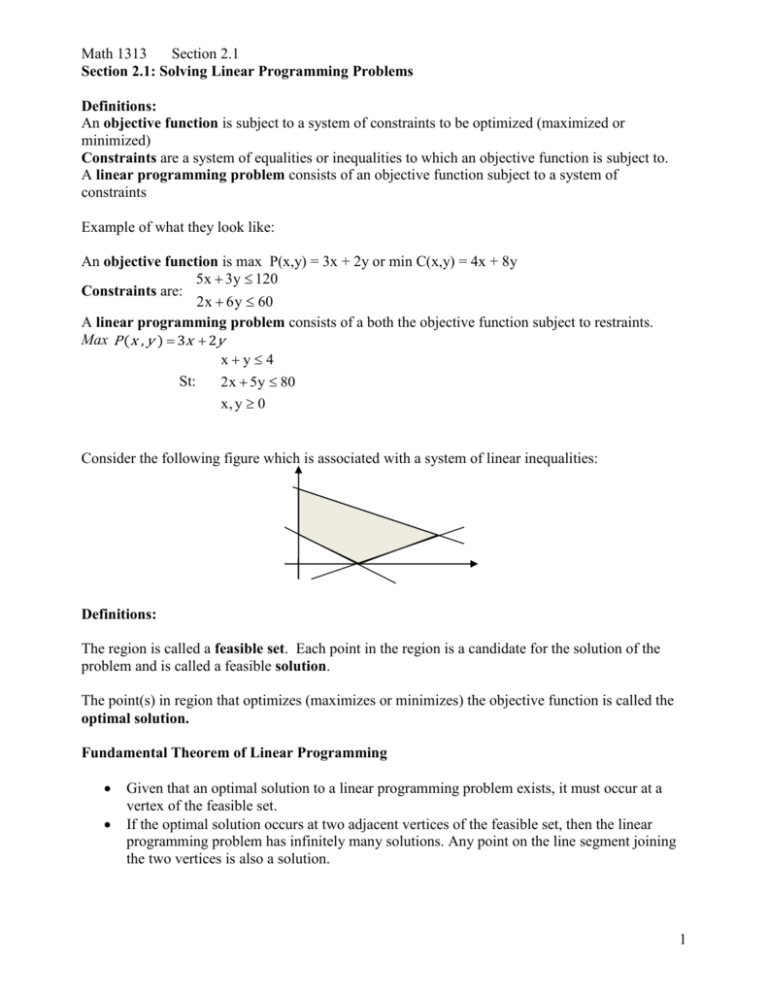
Math 1313 Section 2.1 Section 2.1: Solving Linear Programming Problems Definitions: An objective function is subject to a system of constraints to be optimized (maximized or minimized) Constraints are a system of equalities or inequalities to which an objective function is subject to. A linear programming problem consists of an objective function subject to a system of constraints Example of what they look like: An objective function is max P(x,y) = 3x + 2y or min C(x,y) = 4x + 8y 5x 3y 120 Constraints are: 2 x 6 y 60 A linear programming problem consists of a both the objective function subject to restraints. Max P ( x , y ) 3x 2 y xy4 St: 2 x 5 y 80 x, y 0 Consider the following figure which is associated with a system of linear inequalities: Definitions: The region is called a feasible set. Each point in the region is a candidate for the solution of the problem and is called a feasible solution. The point(s) in region that optimizes (maximizes or minimizes) the objective function is called the optimal solution. Fundamental Theorem of Linear Programming Given that an optimal solution to a linear programming problem exists, it must occur at a vertex of the feasible set. If the optimal solution occurs at two adjacent vertices of the feasible set, then the linear programming problem has infinitely many solutions. Any point on the line segment joining the two vertices is also a solution. 1 Math 1313 Section 2.1 This theorem is referring to a solution set like the one that follows: Maximum Minimum The Method of Corners 1. Graph the feasible set. 2. Find the coordinates of all corner points (vertices) of the feasible set. 3. Evaluate the objective function at each corner points. 4. Find the vertex that renders the objective function a maximum (minimum). If there is only one such vertex, then this vertex constitutes a unique solution to the problem. If the objective function is maximized (minimized) at two adjacent corner points of S, there are infinitely many optimal solutions given by the points on the line segment determined by these two vertices. Example 1: Given the following Linear Program, Determine the vertices of the feasible set. Max profit P ( x , y ) 12x 10 y 15x 10 y 1380 Subject to: 10 x 12 y 1320 x, y 0 2 Math 1313 Section 2.1 Example 2: Given the following Linear Program, Determine the vertices of the feasible set Min D3 3x y 10 x 2 y 84 Subject to: 8x 4 y 120 x, y 0 3 Math 1313 Section 2.1 Example 3: Given the following Linear Program, solve for the optimal solution. Min C (x , y ) 1200x 100y 40 x 8 y 400 Subject to: 3x y 36 x, y 0 4 Math 1313 Section 2.1 Example 4: Maximize the following Linear Programming Problem. Maximize C = 6x + 20y s.t. x + y 16 x + 3 y 36 x0 y0 5 Math 1313 Section 2.1 Example 5: Maximize the following Linear Programming Problem. Maximize C = 2x + 6y s. t. x + 3y < 15 4x + y <16 x≥0 y≥0 6




